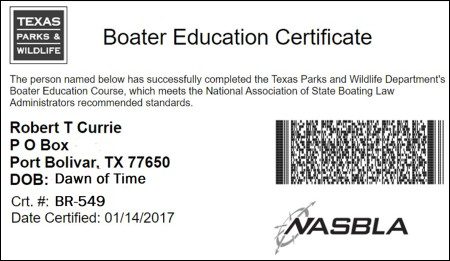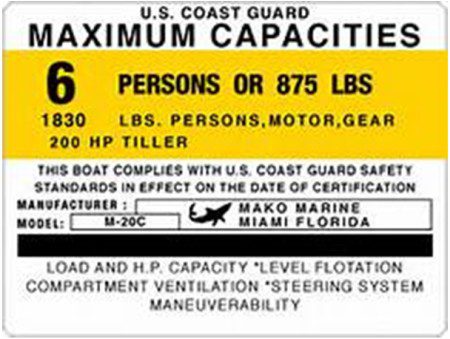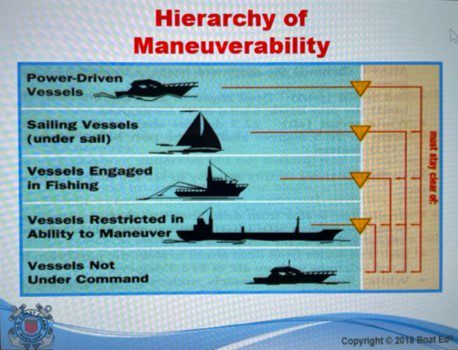 By Bob Currie, Recreational Boating Safety Specialist
By Bob Currie, Recreational Boating Safety Specialist
U. S. Coast Guard Auxiliary Station Galveston Flotilla
If you watch any of the game warden reality shows, you know when the game wardens stop a boat on the water they always ask to see a life jacket for everyone on board, they make sure kids under 13 are wearing their life jacket, they ask to see the throw cushion and the fire extinguisher, they observe to see that the operator is attached to the Emergency Kill Switch, and sometimes, if the operator appears young, they ask to see their Boater Education Certificate.
Boater Education Certificate
If you were born on or after September 1, 1993 (under 30 years of age) and you are the operator of a boat with greater than 15 hp or a sailboat greater than 14 feet in length, you must have taken a state-certified Boater Safety Course. You also must carry your Boater Education Certificate with you.

If you think you have already taken the course but can’t remember, you can go to your state’s fish and game site and often, like in Texas, you will find a Boater Education Certificate checker. But, if you can’t remember if you took the course, it might be time to take a refresher.
Yes, There Are Two Paths You Can Go By
Kudos if you recognize the above as a line from Led Zeppelin’s “Stairway to Heaven.” There are two paths to getting your boater Education Certificate, though. First, you can attend a class given by your state, by the Power Squadron, or by the Coast Guard Auxiliary. Second, you can attend an onine class. In person classes are the best. An online class, although it may have a Frequently Asked Questions section, just can’t answer all your questions. The courses are not free, although the BoatUS class comes close to being free. Members of BoatUS have access to the Boater Education Course for free, so there is the membership fee to consider if you aren’t a member. There are several commercial online presenters. They all have to follow the same outline in their course. This column will be an outline of the Coast Guard Auxiliary Course as taught in person by certified instructors. Coast Guard Auxiliary instructors also have many other in person boating courses they offer. Below are the six chapters of the Auxiliary Course.
Chapter 1: Know Your Boat
Chapter 1 is an introduction to boating terminology. Here are the key topics:
- Parts of a Boat
- Types of Boat Hulls
- Length of a Vessel
- Types of Engines and Drives
- Personal Water Craft (PWC)
- Sailboats
Operating a powerboat and flying a small plane are more similar than operating a powerboat and sailing a sailboat in some cases, so don’t be too quick to dismiss Chapter 1 as being too basic. Do you powerboaters know what a sheet is to sailors? No, it’s not the sail. It’s a line attached to the sail. May a twelve-year-old operate a PWC? Yes, but not by themselves. A person eighteen or older who meets the Boater Education Requirements must be aboard with them.
Chapter 2: Before You Get Underway
After completing this chapter you should be able to:
- Locate and understand a boat’s Capacity Plate
- File a proper float plan
- Explain how to fuel a vessel safely
- Explain how to launch a boat from a trailer and retrieve it from the water safely and courteously
- Give the basics of vessel and engine maintenance
Many of the boating accidents that occur each year are due to a boat being overloaded. The Capacity Plate found on most recreational boats tells you the maximum number of persons, the maximum weight of persons, the maximum weight of the motor + persons + gear, and the maximum horsepower of the motor. Exceeding any of these specifications is a recipe for disaster. People often don’t read or understand the full meaning of the Capacity Plate. A plate might say the Maximum Persons is 7, but then say the maximum weight of the persons is 1050 pounds. If you divide 1050 pounds by 7 persons, you will see that the weight of the average person is only 150 pounds. You must adhere to the lower weight or number of persons. This is important when you invite Big Jim to go fishing with you. Big Jim, how big a feller are you?

For boats under 20 feet in length and without a capacity plate, there is a formula to aid you in determining the boat’s capacity:
Number of People = (Vessel Length x Vessel Width) / 15
That said, check your freeboard before you shove off from the dock. If your gunwale is close to the water, you might have to leave Big Jim on shore. I have had boaters tell me that their boat is unsinkable. Well, that might be the case, but it is still subject to being capsized due to overloading, and persons in the water is never a good thing.
Chapter 3: Operating Your Boat Safely
Chapter 3 is a big chapter and really gets into the meat of things. After completing this chapter you should be able to do the following:
- Give three major responsibilities of a vessel operator
- Explain what to do when encountering another vessel
- List the types of nighttime navigation lights and explain how to interpret them
- Explain what to do when encountering buoys and markers of the U.S. Aids to Navigation System
- Use and understand sound signals
- Anchor a vessel properly
- Operate a PWC safely and courteously
- Explain how an engine cutoff switch works
- Explain what to do when accounting various hazards
I am going to give you Item 1 above: The three major responsibilities of a vessel operator are:
- Practice good seamanship
- Keep a proper lookout
- Maintain a safe speed
Another thing to remember: departure from the rules is okay if necessary to avoid a collision. You are still responsible for any harm you cause while avoiding a collision. Even if it is the other vessel operator’s fault for a collision, it is also your fault. You can never escape responsibility for a collision.

Whenever someone says that sailboats always have the right of way, I know I am dealing with someone who never took a Boater Education Course or someone who slept through Chapter 3. Of course, there is NO right of way on the water- just a Hierarchy of Maneuverability, a pecking order if you will. And you are not, as a recreational boater, a “vessel engaged in fishing” unless you have fishing nets over the side or being pulled behind your boat.
The Legal Requirements of Boating
After completing this chapter you should be able to do the following:
- Tell which vessels are required to be registered and how to do so
- Place certificate numbers and validation decals on a vessel correctly
- Find the Hull Identification Number (HIN) on a vessel
- Explain the age and education restrictions on vessel or PWC operation
- List the reckless or negligent behaviors that should be avoided
- Explain the dangers of consuming alcohol or drugs and the penalties involved
- Tell the laws pertaining obstruction of navigation
- Explain your roe in keeping waterways safe and secure
- State the legal requirements and classifications of fire extinguishers
- State the legal requirements and classifications of life jackets
- Tell the legal requirements for Visual Distress Signals, navigation lights, and sound producing devices
- List the legal requirements specific to PWC
- List the legal requirements for towing a person behind a vessel
- Explain how to dispose of waste, trash and oil properly
- Tell when and how to report a boating accident
Chapter 5: Boating Emergencies … What to Do?
Prevention is the best way to deal with possible boating emergencies. The time to think about how to handle an emergency is before the emergency actually happens. Being prepared can save your life or the life of a passenger. After completing this chapter you should be able to:
- Explain how to practice risk management while boating
- Describe the effects of boating stressors
- Explain how dehydration occurs and how to recognize and prevent it
- Explain the increased effects of alcohol consumption on the body when on the water
- How to find the proper life jacket for a person and inspect its condition
- Explain how to handle situations involving capsizing, swamping, or falling overboard
- Avoid collisions
- Respond properly to a fire emergency
- Take the proper steps if a vessel runs aground
- Explain the dangers of cold water immersion and how to survive
- Recognize the symptoms of carbon monoxide poisoning and how to prevent it
- Obtain weather forecasts and explain what to do if caught in a storm
- Explain how to summon help quickly in an emergency
Chapter 6: Enjoying Water Sports With Your Boat
After completing this chapter you should be able to:
- Explain a vessel operator’s responsibilities to his or her passengers
- Explain a vessel owner’s responsibility when allowing others to use his boat
- Explain the boater’s responsibility to the environment
- Explain a vessel operator’s responsibilities to others using the waterway
- List the safety guidelines for small boat operators
- Properly tow skiers and recognize skier hand signals
- Explain how to fish or hunt safely from a vessel
Summary
The purpose of this article is to show the topics taught in a Boater Education Course so that you may judge for yourself if you need to take such a course.
[BC: Feb-28-2023]

 Posted in
Posted in 























